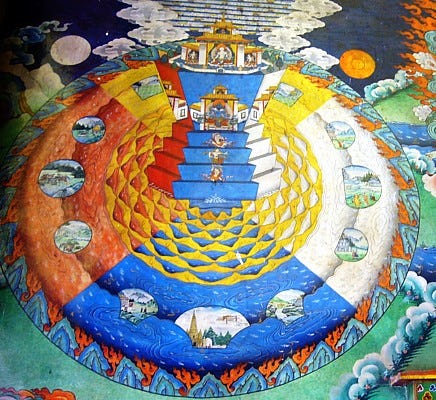Chapter 1: The divine root conceives, its source revealed; Mind and nature nurtured, the Great Dao is born.
In which the world is born and we meet the famous Monkey King, Sun Wukong, who is seeking inmortality.
Welcome everybody to the first chapter of Journey to the West. If you’re reading from your own copy of Anthony Yu’s translation, you will already have the notes to the text that he added, so I won’t copy those in order not to be sued by the owners of the work. These notes are in chronological order.
In reference to the title of the poem, in Daoism, the Dao or Tao (“The Way”) is the source and ideal of all existence: it is unseen, but not transcendent, immensely powerful yet supremely humble, being the root of all things. is the source and ideal of all existence: it is unseen, but not transcendent, immensely powerful yet supremely humble, being the root of all things. I’ll slip a book recommendation for anyone interested in learning more: The Tao of Pooh by Benjamin Hoff.
“We heard that, in the order of Heaven and Earth, a single period consisted of 129,600 years. Dividing this period into twelve epochs were the twelve stems of Zi, Chou, Yin, Mao, Chen, Si, Wu, Wei, Shen, Yu, Xu, and Hai…” You must know that early Chinese culture relied on several timekeeping notations to keep track of days, months, and years. Among these were the familiar methods of numbering the months of the year from one to twelve and counting years in terms of the reigns of rulers. However, one form of timekeeping was independent of the events or history and even of the rhythms of nature. This was a system of counting that involved the combination of two series of signs, which yielded a total of 60 possible combinations. This is called the system of “Heavenly Stems and Earthly Branches.” The year is designated by the Stems and Branches System, combining one of the ten characters representing the Heavenly Stems with one of the twelve characters representing the Earthly Branches. This makes possible sixty combinations or pairs, known as a cycle of 60 years, jiazi 甲子or a huajia 花甲. According to this system, the first year of a sixty-year cycle (jiazi) is the combination of the first character of the Heaven Stems with the first character of the Earthly Branches, i.e., Jiazi 甲子, the second year yichou 乙丑, and the third year bingyin 丙寅, and so on and so forth.
“Considered as the horary circle, the sequence would be thus: the first sign of dawn appears in the hour of Zi, while at Chou the cock crows; daybreak occurs at Yin, and the sun rises at Mao; Chen comes after breakfast, and by Si everything is planned; at Wu the sun arrives at its meridian, and it declines westward by Wei; the evening meal comes during the hour of Shen, and the sun sinks completely at Yu; twilight sets in at Xu, and people rest by the hour of Hai.” For more information about the division of the day, read here. The Romans also divided the day in various periods, such as hora prima, hora sexta…
“…the epoch of Zi drew near and again brought gradual development” In here, the author divided each phase of the creation of the world, giving a name to each phase that belongs also to a Heavenly Stem. It’s like in Christianity, when we said God created the world in seven days, and we say that on X day he did Y thing.
“Great was the male principle; / Supreme, the female!” When the author speaks about “male”and “female”, he is speaking in Daoist terms of the ying and yang, which are opposites but compliment each other, and so it’s also easier to use male and female.
“They were: the East Pūrvavideha Continent, the West Aparagodānīya Continent, the South Jambūdvīpa Continent, and the North Uttarakuru Continent.” According to traditional Buddhist cosmology, our world system is comprised of four continents and eight subcontinents surrounding Mount Meru.
“On the stone were also nine perforations and eight holes, which corresponded to the Palaces of the Nine Constellations and the Eight Trigrams.” This paper explains some of it but it is a complex taoist concept that I don’t understand myself.
“Where do they live?” asked the Monkey King. The monkey said, “They do not live beyond the world of the Jambūdvīpa, for they dwell within ancient caves on immortal mountains.” In Buddhism, saṃsāra is the "suffering-laden, continuous cycle of life, death, and rebirth, without beginning or end".




“Where do they live?” asked the Monkey King. The monkey said, “They do not live beyond the world of the Jambūdvīpa, for they dwell within ancient caves on immortal mountains.”
Isn't he currently living on an immortal mountain and dwelling within an ancient cave?
“ Lo, this utterance at once led him
To leap free of the Transmigration Net,
And be the Great Sage, Equal to Heaven.”
If he's already free from the net of transmigration and already a great sage, isn't he already done? Why still leave?
And today I learned that "Sun" has a surprisingly close meaning to "son"!